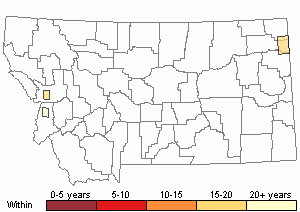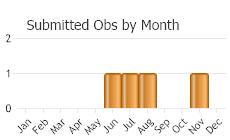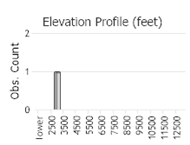View in other NatureServe Network Field Guides
NatureServe
Montana
Utah
Wyoming
Idaho
Wisconsin
British Columbia
South Carolina
Yukon
California
New York
Peck's Skipper - Polites coras
Other Names:
Polites peckius
Native Species
Global Rank:
G5
State Rank:
S5
Agency Status
USFWS:
USFS:
BLM:
External Links
General Description
[From Ferris and Brown 1981; Scott 1986; Layberry et al. 1998; Opler and Wright 1999; Glassberg 2001; Pyle 2002] Forewing 1.1-1.2 cm. Uppersurface dark brown with restricted yellow patches and yellow apical spots, male forewing with gray-brown patch below sinuous black stigma extending almost to darker border, stigma with yellow interior felt; undersurface of hindwing chestnut-brown with a broad postmedian patch of yellow spots surrounded by darker border, the central yellow spot jutting outward, a second smaller yellow patch near hindwing base.
Phenology
One flight, mostly July in the north and at higher elevation; two flights, late May to mid-June and late July to mid-September elsewhere (Scott 1986). Mid-June to early August in one-brood areas, May to September in two-brood areas (Glassberg 2001). Late June to early August in Canada (Layberry et al. 1998). Late July to mid-August in eastern Nebraska (Bray 1994), early June to mid-August in western Pennsylvania (Clench 1967). July to August in mountains of the Rocky Mountain states, May to August in the prairies (Ferris and Brown 1981). Late June to early August Washington and Oregon (Pyle 2002), mid-June to late July in Oregon (Warren 2005), late June to early August in British Columbia (Guppy and Shepard 2001).
Diagnostic Characteristics
Best determined by a combination of the overall dark brown base color with restricted yellow patches, the undersurface of the hindwing chestnut-brown with a broad postmedian patch of yellow spots surrounded by darker border, the central yellow spot jutting outward, a second smaller yellow patch near hindwing base.
Species Range
Montana Range
Range Descriptions

 Native
Native
Range Comments
British Columbia east across southern Canada to Labrador, Newfoundland, Nova Scotia, south in the west to northeastern Oregon, east-central Arizona, southern Colorado, northern Texas, south in the east to northeastern Oklahoma, northern Alabama, northern Georgia (Scott 1986; Layberry et al. 1998; Opler and Wright 1999; Glassberg 2001); to about 3100 m elevation in the Rocky Mountain states (Ferris and Brown 1981), to at least 2682 m elevation in Colorado (Brown 1957), 914 m to at least 1524 m elevation in Oregon (Warren 2005). In Montana, reported from at least 34 counties across the state (Kohler 1980; Stanford and Opler 1993; FLMNH Lepidopterists' Society database), to at least 1235 m elevation. Locally uncommon to locally common (Glassberg 2001).
Observations in Montana Natural Heritage Program Database
Number of Observations: 4
(Click on the following maps and charts to see full sized version)
Map Help and Descriptions
Relative Density

Recency



 (Observations spanning multiple months or years are excluded from time charts)
(Observations spanning multiple months or years are excluded from time charts)
Migration
Non-migratory.
Habitat
Moist and dry grassy areas, montane meadows, prairie marsh edges, roadsides, urban lawns (Clench 1967; Scott 1986; Layberry et al. 1998; Opler and Wright 1999; Glassberg 2001; Pyle 2002); most abundant in degraded fields and barrens in midwestern prairie fragments (Swengel and Swengel 2015). Habitat in Montana not described but probably similar.
Food Habits
Larval food plants are grasses, including Distichlis spicata, Leersia oryzoides, and Poa pratensis, possibly Bromus inermis (Ferris and Brown 1981; Scott 1986, 1992, 2006; Layberry et al. 1998; James and Nunnallee 2011). Adults feed on flower nectar, including Achillea, Asclepias, Astragalus, Buddleja, Carduus, Centranthus, Ceratostigma, Chrysanthemum, Cirsium, Echinacea, Erigeron, Euphorbia, Gomphrena, Hesperis, Lavandula, Leucanthemum, Liatris, Lobelia, Lupinus, Lychnis, Malva, medicago, Nepeta, Prunella, Rudbeckia, Salvia, Scabiosa, Solidago, Sonchus, Symphoricarpos, Symphyotrichum, Tagetes, Taraxacum, Teucrium, Thermopsis, Trifolium, Verbena, Vernonia, Vicea, and Zinnia (Clench 1967; Bray 1994; Pyle 2002; James and Nunnallee 2011; Scott 2014).
Reproductive Characteristics
Females lay eggs singly on or near host plant leaves; eggs drop to ground because they lack glue (Scott 1986, 1992; James and Nunnallee 2011). Eggs hatch in about 8-9 days, grow slowly in captivity from L1 instar to L3 instar in about 40 days, feed slowly another 30 days and diapause (overwinter) as half-grown (L3-L4 instars) or mature (L5 instar) larvae, possibly pupae. Larvae feed on host plant leaves, probably feed nocturnally, build silk-tied leaf-tube nests low on host plant or below ground, pupate in loose cocoon inside leaf nest near host plant base on in upper soil layer (Scott 1986, 1992; Guppy and Shepard 2001; James and Nunnallee 2011). Males perch throughout the day on tall grasses in grassy swales awaiting passing females (Scott 1986; James and Nunnallee 2011).
References
- Literature Cited AboveLegend:
 View Online Publication
View Online Publication Bray, T. 1994. Nectar-seeking visits by butterflies in a tallgrass prairie remnant in eastern Nebraska. Transactions of the Nebraska Academy of Sciences. 21:63-72.
Bray, T. 1994. Nectar-seeking visits by butterflies in a tallgrass prairie remnant in eastern Nebraska. Transactions of the Nebraska Academy of Sciences. 21:63-72. Clench, H.K. 1967. Temporal dissociation and population regulation in certain hesperiine butterflies. Ecology.48:1000-1006.
Clench, H.K. 1967. Temporal dissociation and population regulation in certain hesperiine butterflies. Ecology.48:1000-1006. James, D.G. and D. Nunnallee. 2011. Life histories of Cascadia butterflies. Corvallis, OR: Oregon State University Press. 447 p.
James, D.G. and D. Nunnallee. 2011. Life histories of Cascadia butterflies. Corvallis, OR: Oregon State University Press. 447 p. Scott, J.A. 1992. Hostplant records for butterflies and skippers (mostly from Colorado) 1959-1992, with new life histories and notes on oviposition, immatures, and ecology. Papilio new series #6. 185 p.
Scott, J.A. 1992. Hostplant records for butterflies and skippers (mostly from Colorado) 1959-1992, with new life histories and notes on oviposition, immatures, and ecology. Papilio new series #6. 185 p. Scott, J.A. 2006. Butterfly hostplant records, 1992-2005, with a treatise on the evolution of Erynnis, and a note on new terminology for mate-locating behavior. Papilio new series #14. 74 p.
Scott, J.A. 2006. Butterfly hostplant records, 1992-2005, with a treatise on the evolution of Erynnis, and a note on new terminology for mate-locating behavior. Papilio new series #14. 74 p. Scott, J.A. 2014. Lepidoptera of North America 13. Flower visitation by Colorado butterflies (40,615 records) with a review of the literature on pollination of Colorado plants and butterfly attraction (Lepidoptera: Hersperioidea and Papilionoidea). Contributions of the C.P. Gillette Museum of Arthopod Diversity. Fort Collins, CO: Colorado State University. 190 p.
Scott, J.A. 2014. Lepidoptera of North America 13. Flower visitation by Colorado butterflies (40,615 records) with a review of the literature on pollination of Colorado plants and butterfly attraction (Lepidoptera: Hersperioidea and Papilionoidea). Contributions of the C.P. Gillette Museum of Arthopod Diversity. Fort Collins, CO: Colorado State University. 190 p. Swengel, A.B and S.R. Swengel. 2015. Grass-skipper (Hesperiinae) trends in midwestern USA grasslands during 1988-2013. Journal of Insect Conservation 19:279-292.
Swengel, A.B and S.R. Swengel. 2015. Grass-skipper (Hesperiinae) trends in midwestern USA grasslands during 1988-2013. Journal of Insect Conservation 19:279-292.
- Additional ReferencesLegend:
 View Online Publication
View Online Publication
Do you know of a citation we're missing? Allen, T.J., J.P. Brock, and J. Glassberg. 2005. Caterpillars in the field and garden: a field guide to the butterfly caterpillars of North America. Oxford University Press.
Allen, T.J., J.P. Brock, and J. Glassberg. 2005. Caterpillars in the field and garden: a field guide to the butterfly caterpillars of North America. Oxford University Press. Brock, J.P. and K. Kaufman. 2003. Kaufman Field Guide to Butterflies of North America. Houghton Mifflin Company, New York, NY 284 pp.
Brock, J.P. and K. Kaufman. 2003. Kaufman Field Guide to Butterflies of North America. Houghton Mifflin Company, New York, NY 284 pp. Forister, M.L., C.A. Halsch, C.C. Nice, J.A. Fordyce, T.E. Dilts, J.C. Oliver, K.L. Prudic, A.M. Shapiro, J.K. Wilson, J. Glassberg. 2021. Fewer butterflies seen by community scientists across the warming and drying landscapes of the American West. Science 371:1042-1045.
Forister, M.L., C.A. Halsch, C.C. Nice, J.A. Fordyce, T.E. Dilts, J.C. Oliver, K.L. Prudic, A.M. Shapiro, J.K. Wilson, J. Glassberg. 2021. Fewer butterflies seen by community scientists across the warming and drying landscapes of the American West. Science 371:1042-1045. Forister, M.L., E.M. Grames, C.A. Halsch, K.J. Burls, C.F. Carroll, K.L. Bell, J.P. Jahner, et al. 2023. Assessing risk for butterflies in the context of climate change, demographic uncertainty, and heterogeneous data sources. Ecological Monographs 93(3):e1584. https://doi.org/10.1002/ecm.1584
Forister, M.L., E.M. Grames, C.A. Halsch, K.J. Burls, C.F. Carroll, K.L. Bell, J.P. Jahner, et al. 2023. Assessing risk for butterflies in the context of climate change, demographic uncertainty, and heterogeneous data sources. Ecological Monographs 93(3):e1584. https://doi.org/10.1002/ecm.1584 Fultz, J.E. 2005. Effects of shelterwood management on flower-visiting insects and their floral resources. M.Sc. Thesis. Bozeman, MT: Montana State University. 163 p.
Fultz, J.E. 2005. Effects of shelterwood management on flower-visiting insects and their floral resources. M.Sc. Thesis. Bozeman, MT: Montana State University. 163 p. Glassberg, J. 2001. Butterflies through Binoculars: A Field Guide to the Butterflies of Western North America. Oxford University Press.
Glassberg, J. 2001. Butterflies through Binoculars: A Field Guide to the Butterflies of Western North America. Oxford University Press. Layberry, R.A., P.W. Hall, and J.D. LaFontaine. 1998. The Butterflies of Canada. University of Toronto Press. 280 pp. + color plates.
Layberry, R.A., P.W. Hall, and J.D. LaFontaine. 1998. The Butterflies of Canada. University of Toronto Press. 280 pp. + color plates. Stanford, R.E. and P.A. Opler. 1993. Atlas of western USA butterflies: including adjacent parts of Canada and Mexico. Unpubl. Report. Denver and Fort Collins, Colorado 275 pp.
Stanford, R.E. and P.A. Opler. 1993. Atlas of western USA butterflies: including adjacent parts of Canada and Mexico. Unpubl. Report. Denver and Fort Collins, Colorado 275 pp.
- Web Search Engines for Articles on "Peck's Skipper"
- Additional Sources of Information Related to "Insects"





